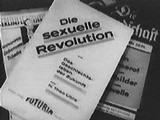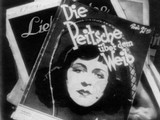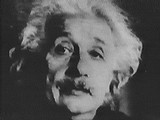 |
 |
We might also ask, from a more historical perspective: what can it
teach us about the world-view of its creators - who include not only
Joseph Goebbels, the mastermind behind its production, but also Adolf
Hitler? Hitler not only approved the idea, he saw the very first edits,
and gave Goebbels instruction on how to cut the final version.
Hitler also provides the emotional climax of the film, with footage
of his
speech to the Reichstag from 1939.
When preceded by sixty minutes describing the Jewish problem, and
followed by thunderous applause, Hitler's prophetic warning takes on
even greater significance:
| Wenn es dem internationalen Finanzjudentum in und
außerhalb Europas gelingen sollte, die Völker noch einmal
in einen Weltkrieg zu stürzen, dann wird das Ergebnis nicht der
Sieg des Judentums sein, sondern die Vernichtung der jüdischen
Rasse in Europa! |
 |
If the international finance-Jewry inside and outside Europe
should succeed in plunging the nations into a world war yet again,
then the outcome will not be the victory of Jewry, but rather the
annihilation of the Jewish race in Europe! |
The importance of this groundbreaking propaganda is often
underestimated. Stig Hornshøj-Møller takes us inside the
film, its making, its meaning in 1941, and its meaning today. The
Holocaust History Project is pleased to present four of his papers and
talks on the film, given at four conferences on the Holocaust.

Papers
- March 2, 1997:
Tampa
- The paper discusses the possibilities and dangers of using
authentic Nazi anti-Semitic film propaganda as a means of teaching the
reasons behind the Holocaust. It argues that [Der ewige Jude] had a
major impact on Hitler's final decision to launch the genocide because
of its "reality-like" character. The main section of the paper consists
of a report on almost 25 years of Danish and German experiences of the
effects of showing the film to young people of today for educational
purposes...
- June 11,
1997: Montreal (oral presentation)
- I would like to raise and discuss the highly complex question
of the integration of non-written evidence into inter-disciplinary
research, and I will try to argue why I consider the Nazi propaganda
film "Der ewige Jude" to be an X-ray of the Holocaust decision-making
process itself.
- June
11, 1997: Montreal (written paper)
- The paper presents a core summary of my Danish book "The
Führer-Myth: Adolf Hitler, Joseph Goebbels and the History Behind
a Genocide." It argues the importance of a Nazi propaganda film, "Der
ewige Jude," which is characterized as an X-ray of the decision-making
process that led to the Holocaust.... The paper furthermore argues that
the film can be seen as the official promulgation of Hitler's decision,
and that it - together with the feature film Jud Süß -
deliberately was used to prepare both perpetrators and bystanders for
the extermination of the Jews.
- November 17,
1997: London
- "Der ewige Jude" ... gives us an X-ray of the legitimization of
the Holocaust and challenges us individually with the uncomfortable
moral question: What would you have done? How do you react to
atrocities today, which you can follow almost live on television?
- April 27,
1998: Millersville
- Should we, who favor a democratic society, really still be so
scared of an almost sixty-year-old hate-picture, that we pretend that
it does not exist - and thus in practice leave it to those whose racism
it confirms and strengthens?
Should we not instead dare to use the film actively, as part of
Holocaust education, and dare to demonstrate the authentic poison in it
in order to vaccinate future generations?

Also of Interest
Still images from the film, eighty-three
in number, along with the text of the narration in German and English.
An audio clip of Hitler's
prophecy, from near the end of the film, of the coming
"annihilation" of the Jews of Europe. This speech provides the
resolution of the crisis which is built up throughout the entire film;
one might say that Hitler's promise to the German people is the
denouement. A transcription, and translation into English, are
provided. To hear the audio requires the free
RealPlayer
(also known as the RealAudio Player).
The film program, a description of what
is found in the film, as written by the Illustrierte Filmkurier
and, in Germany during the war, given to its viewers before they
entered. In English und auf Deutsch.
Hilfsmittel für Lehrer.
Teaching material prepared by Dr. Hornshøj-Møller: this
includes a single-page (double-sided) handout for students to take
home the day before seeing the film, a pre-questionnaire, a
post-questionnaire, and more. Nur auf Deutsch.
More detail on the films described can be found at the Internet Movie
Database:
Jud Süß aka Jew Suess (1940)
Der ewige Jude aka The Eternal Jew (1940)

About the Author
Dr. Stig Hornshøj-Møller (Danish mag. art.) has been
studying the film The Eternal Jew since 1970. He is the
author of Der ewige Jude: Quellenkritische Analyse eines
antisemitischen Propagandafilms ("Source-Critical Analysis of
an Antisemitic Propaganda Film"), Institut für den
Wissenschaftlichen Film, Göttingen, 1995. (This work is also
available in a special free printing, which interested readers can
order from the Bundeszentrale für politische Bildung, Postfach
1369, 53111 Bonn.)

Notes
1. "Der ewige Jude": Quellenkritische
Analyse eines antisemitischen Propagandafilms, Institut für
Wissenschaftlichen Film, Göttingen, 1995, p. 134.
2. Montreal paper, footnote
31.
|



![]()




![]()